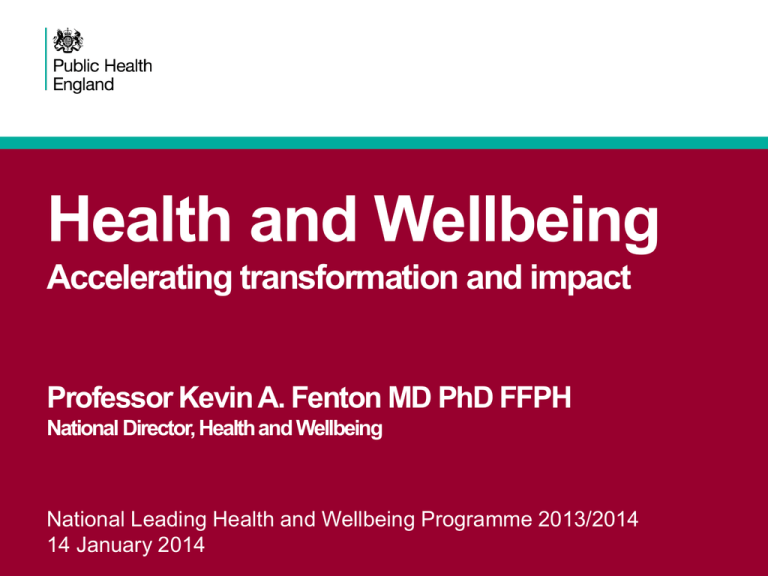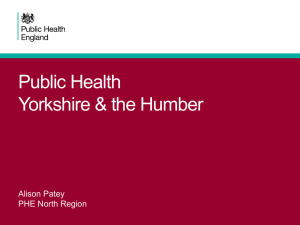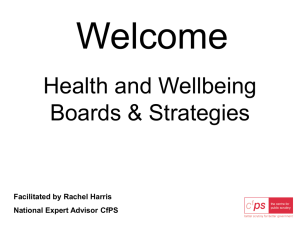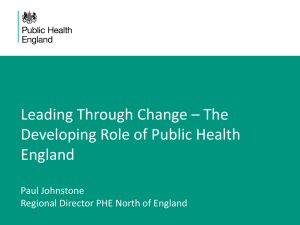Health and Wellbeing
advertisement

Health and Wellbeing Accelerating transformation and impact Professor Kevin A. Fenton MD PhD FFPH National Director, Health and Wellbeing National Leading Health and Wellbeing Programme 2013/2014 14 January 2014 Content 2 1 Transformation: The new public health system 2 Public Health England: Mission; role; priorities 3 Accelerating progress: Scale of the ambition 4 Challenges and Opportunities 5 Leadership: In public health; across the system Transformation The new public health system Health System Transformation • Health & Social Care Act 2012: wholesale system change across health and social care • National Health Service reform • Refocusing on public health and prevention • Localism • Focusing on outcomes not targets • Changes implemented from 1 April 2013 4 The new PH system provides an opportunity for renewed action and improved outcomes Government Local authorities DH responsible to parliament New public health functions, helping to tackle wider determinants of health Cross-government senior officials group to improve health outcomes CMO to provide independent advice to government Public Health England Lead on improving health and coordinate protecting health Promote population health and wellbeing (DPHs) New, integrated national expert body NHS England Strengthened health protection systems Delivering health care, tackling inequalities Supporting whole system with expertise, evidence and intelligence Making every contact count Specific public health interventions, such as cancer screening Local leadership in public health • Health and wellbeing boards: central to local government’s role as public health leaders. • No one size fits all. Boards differ depending on • • • Local priorities Local partners, stakeholders, agendas Local assets, including VCs and businesses • Democratic legitimacy • • 6 Elected council members Healthwatch represent views of local people Health and wellbeing boards • Nearly all have produced joint strategic needs assessments (JSNA) and joint health and wellbeing strategies (JHWS) • Public health and health inequalities: top priority • Keen to play bigger role in commissioning services Source: The King’s Fund. Health and wellbeing boards. One year on. 31 October 2013 Public Health England Mission; Role; Priorities Public Health England System Leadership: Work transparently, provide government, local government, the NHS, MPs, industry, public health professionals and the public with evidence-based professional, scientific and delivery expertise and advice Protection: Ensure there are effective national and local arrangements for preparing, planning and responding to health protection concerns and emergencies, including the future impact of climate change Local Support: Support local authorities and clinical commissioning groups by providing evidence and knowledge on local health needs, alongside practical and professional advice on what to do to improve health 9 10 PHE’s outcomes focused priorities for FY13/14 1 Help people to live longer and healthier lives 2 Reduce the burden of disease and disability 3 Protect the country from infectious diseases and environmental hazards 4 Support families to give children and young people the best start in life 5 Improve health in the workplace PHE’s Health and Wellbeing priorities 1 Support people to live healthier lives via NHS Health Checks 2 Promote tobacco control and reduce smoking 3 Promote healthy weight and tackle childhood obesity 4 Improve recovery rates from drug dependency 5 Improve sexual health and reduce the burden of STIs 6 Develop a national programme on mental health 7 Lead gold standards for vaccination and screening programmes 8 Make the case for promoting wellbeing, prevention and early intervention as the best approach to improving health 9 Partner NHS England to maximise improvements in public health Accelerating progress Scale of the ambition Accelerating impact on NCDs • There is a rising tide of Non-Communicable Disease (NCD) in England. • Many NCDs: associated with inequalities in health • UK’s underperformance on premature mortality • Focus on major drivers of disease, disability, disadvantage and death Source: Murray C et al. UK health performance: findings of the Global Burden of Disease Study 2010. Lancet 2013; 381: 9971020 We need new approaches, new vision • Focus on the risk factors, upstream causes • Maximise impact by working with range of stakeholders • Shift national focus to prevention and wellbeing: campaigns and engagement • Translate evidence into best practice The burden of disease: risk factors 15 http://www.healthmetricsandevaluation.org; The Lancet, Early Online Publication, 5 March 2013doi:10.1016/S0140-6736(13)60355-4 Focus on the risk factors • NHS Health Check implementation: - World-leading risk awareness, risk assessment, risk and disease management programme - Aimed at 15m people (aged 40-74) - Top ten risk factors for premature death/disability - Prevent 1,600 heart attacks and strokes, detect 20,000 cases of diabetes or kidney disease earlier, avoid 3,250 premature deaths over 5 years Focus on the risk factors • High blood pressure About 30% of adults in England have high blood pressure1, of whom over 4 million are undiagnosed2. Of those in treatment, almost 40% have not reduced their blood pressure enough to be deemed ‘controlled’3. High blood pressure is the second biggest risk factor of disease leading to premature mortality in this country5. It is a major risk factor for stroke, heart attack, heart failure, chronic kidney disease and cognitive decline 1. Health Survey for England 2011, defined as 140/90mmHg or above, adults as 16+ / 2. Health Survey for England 2011 (34% undetected in women, 39% undetected in men) and ONS mid-2012 England population estimates. Note, the DH CVD outcomes strategy estimated 6.8m (47%) undiagnosed / 3. Health Survey for England 2011 (63% of all men and 61% of women receiving drug treatment now with blood pressure below 140/90mmHg) / 4. Joffres et al. (2013) ‘Hypertension prevalence, awareness…’, BMJ / 5. Global burden of disease: UK study 2013 Maximising impact: working together • PHE engagement with voluntary and commercial sector: potential for wider impact of NHS Health Check • PHE support for Health and Wellbeing Boards (15 Centres, local information and intelligence): evidence to inform local health strategy • PHE work with NICE: translate evidence into practice, improve quality and standards National focus on prevention Campaigns to shift the debate to health promotion Be clear on cancer National bowel campaign: 40% rise in two-week referrals Regional lung campaign:14% rise in diagnoses Smokefree Homes & Cars 37% who saw ads reduced their second-hand smoke 85,000 smokefree kits distributed Smart Restart Stoptober 150,000 families (300,000 children) signed up 700,000 engaged in 2013 App downloaded more than 100,000 times 200,000 registered for support products 20 Evidence and best practice • Data that are relevant to local public health leaders (Longer Lives, Health Profiles, Excess Winter Deaths Index) • Data that highlight new developments (NCMP: prevalence of obesity reduced for Year 6 children) • Evaluation of interventions (NHS Health Check) Source: National Child Measurement Programme – England, 2012-13 school Year (NS). Health & Social Care Information Centre. December 11 2013. Accessed at: http://www.hscic.gov.uk/catalogue/PUB13115 Challenges/Opportunities 22 Challenges: change and complexity • Changes to public health landscape: require new structures, new relationships • How will this impact on commissioning and pathways of care (eg: in STIs) • Economic hardships: how do we assess their impact on public health? • Our mission to improve health and address inequalities: extremely complex problems 23 Opportunities: local agenda, integration • We have an unparalleled opportunity to drive system transformation • The new national focus on health and wellbeing follows and complements local government leadership • A focus on health in all policies: integrating health considerations into broad range of policy areas (employment, education, social policy) Leadership In public health; across the system 25 Leadership in public health • We need to change the narrative: from healthcare to health and resilience • We need to set out the case for evidence-based interventions to improve health and wellbeing at all levels Health and Wellbeing Framework Leadership in public health • Monitor impact and effectiveness of interventions • Highlight areas of concern where there is potential impact on public health • Set the bar high: a number of other countries have better record on premature mortality than UK Source: Murray C et al. UK health performance: findings of the Global Burden of Disease Study 2010. Lancet 2013; 381: 997-1020 27 Leadership across the system Leverage opportunities for cross-government health agenda Housing Work Crime and violence Early intervention • Good housing drives health • 20,000 excess deaths each winter Physical activity • Reduces risk of illness by up to 50% • 2/3 of adults obese or overweight • Work a key health determinant • Poor health keeps people out of work Healthy Food • 1/3 children in Y6 obese or overweight • Cost of obesity to NHS £5bn a year Smoking • Leading cause of premature mortality • Estimate cost to economy £13bn Healthy community • Isolation significant driver of poor health • Poor environments lead to social isolation • Alcohol a factor in 44% of violent crime • Foundations for every aspect of development laid in childhood Concluding thoughts 29 Summary • Greater investment in strengthening health improvement programmes could be part of solution on NCDs • We need to focus on integrated, upstream approaches • Even in environment of localism, areas with limited resources can focus on cost effective population approaches Thank you National Leading Health and Wellbeing Programme 2013/2014 14 January 2014 Professor Kevin A. Fenton National Director, Health and Wellbeing Email: Kevin.Fenton@phe.gov.uk Twitter: @ProfKevinFenton







